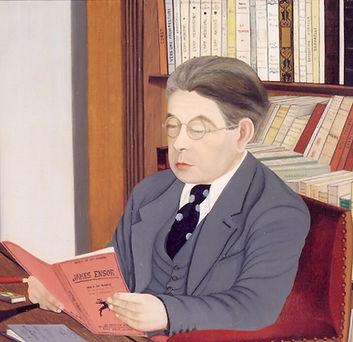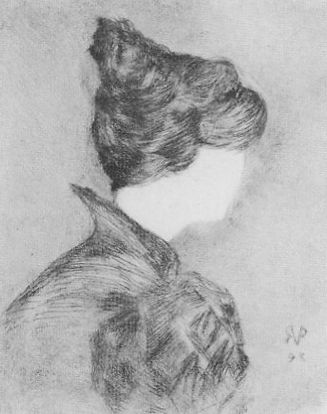
The following are twelve elusive elements of the mysterious death of Vincent van Gogh that are still begging for further investigation by any amateur sleuth out there with a passion for the subject and plenty of time on his hands:
1. LETTER T41b -- This is the Holy Grail of the Mystery of Auvers: the reputed last communication between the Van Gogh Brothers written the day before the shooting of July 27, 1890 that may be evidence of first-degree murder. After lying in a Lyon armoire for more than sixty years, it reportedly came to light in the mid-1950s and was last seen in the hands of then French Interior Minister François Mitterrand. Did he destroy it, as some speculate, or is it gathering dust somewhere in the Ministry’s acres of files? For that matter, did it ever really exist or is it merely urban legend?
2. ADELINE RAVOUX -- The thirteen-year-old daughter of the innkeepers of Vincent’s last residence (painted by him three times in his final days) emerged from the shadows of history as a seventy-eight-year-old widow in 1953 with a radically different account of the Van Gogh death scene and a shocking suggestion of what might have really transpired in the wheatfield. She later changed this testimony, possibly under government pressure. It’s known that she had descendants but, so far, none of them have ever been located. Is it possible that this enigmatic woman, who died in 1965 at the age of eighty-eight, passed down, by word or on paper, some clarifying information about her role in the drama?
Unraveling
The
Mystery of Auvers
A Wish List


Portrait of Adeline Ravoux
BY VINCENT VAN GOGH, 1890

4. DR. MAZERY -- In the traditional account from the 1928 book, La Folie de Vincent van Gogh, Dr. Gachet consulted with a certain Dr. Joseph Mazery about the gunshot wound and they both agreed it would be best to do nothing: just let it heal on its own. But Mazery had been dead for nearly a decade when that book came out and its source for his presence at the Ravoux Inn was Paul Gachet Jr. In her 1953 and 1956 interviews, Adeline Ravoux insists Mazery was never present that night. It’s also not clear precisely where this mystery doctor practiced. Ravoux describes him as a “physician from Pontoise” and Theo refers to him in a later letter as “the village doctor.” In other accounts he’s an obstetrician from Paris who was merely vacationing in Auvers. Is it possible to clear this up?

SKETCH OF UNIDENTIFIED BOY
BY VINCENT VAN GOGH, 1890
5. RENÉ SECRÉTAN -- In 1957, this eighty-two-year-old Parisian came forward with a strange story of how, as a sixteen-year-old boy living in Auvers, he had viciously bullied Vincent over the edge and then made available to him the suicide weapon. His confession, for many reasons, was never taken seriously by history but (by providing a motive and a weapon) it effectively put down the rising whirlwind of journalistic doubt about the suicide at the time. Is there any further information about this shadowy man who two separate veterans of the era contend was a government stooge coached with that story and planted in the press to end the controversy?

8. BLANCHE DEROUSSE -- The real mystery woman of Auvers may be less Adeline Ravoux than this femme fatale who was Dr. Gachet’s artistic protégé and perhaps mistress in his waning days. The niece of Dr. Gachet’s longtime housekeeper, she figures in both the Gachet Collection Scandal of the ’50s (she was accused of being part of Gachet’s forgery ring) and the legend of the missing Letter T41b (which she may have lifted from Gachet for purposes of blackmail). But otherwise little is known about her except that she was a moderately talented painter who was born in Neuilly in 1873 and died on April 10, 1911. Did she perhaps leave a diary that would cast some light on her involvement? What happened to her nephew, who also figures in the saga of the missing letter?

Portrait of Maximilien Gauthier
BY EVE JEAN, 1939
10. LOUIS DUMOULIN & WALPOLE BROOKE -- Numerous artists, some minor (Anton Hirschig, Émile Bernard, Martinez de Valdivielse) and some major (Paul Gauguin, Claude Monet, August Rodin), make an appearance in the Mystery of Auvers. The most intriguing of these may be two temporary painter-residents of Auvers who particularly interested Vincent because they had each lived in Japan. One was Louis-Jules Dumoulin, a Frenchman who Vincent told Theo he very much wanted to meet, and who left Auvers (for French Indochina) the very day after the shooting. The other is Walpole Brooke, an Australian who we know for certain Vincent did meet, and even painted beside in the final weeks. Each could well have known
3. THE GUN -- The pistol that killed Vincent van Gogh was never found, or, for that matter, glimpsed by anyone in Auvers before the shooting. Where did it come from? Handguns were rare in a village like Auvers-sur-Oise in the 1890s and Vincent was specifically known not to own one before he moved there. What happened to it after the shooting? A search was made the next day but it turned up nothing. Sixty years later, a rusty relic mysteriously turned up in an Auvers wheatfield that another sixty years later, in our time, received a great deal of publicity and was auctioned off in 2019 as "the most famous weapon in the history of art." But a former French secret service agent interviewed in 1993 claims that gun is a hoax, planted in 1955 to help put down a host of challenges that year to the suicide scenario. Is there a more reliable candidate somewhere in the Ile de France or the bottom of the Oise that could be matched to the bullet that (if it wasn’t taken by the Gachets in their 1905 exhumation) still rests with Vincent’s bones in the Auvers cemetery?


6. THEO’S MEDICAL REPORT -- When the medical records of Theo van Gogh’s brief stay and mysterious death in Utrecht’s Willem Arntsz Clinic were unsealed in the 1990s, it was discovered that the concluding pages of the file -- those recording the last four days of his life -- had unaccountably disappeared. These pages would have contained, among other information pertinent to the Mystery of Auvers, a description of anything Theo might have said in his final hours, including any deathbed confessions. A clinic spokesman claims that, since no one else had access, the pages must have been taken by someone in the Van Gogh family. What happened to those pages? What did they reveal that would make someone need to suppress them?
7. THE GACHET MANUSCRIPT -- Dr. Gachet spent much of the last two decades of his life working on an ambitious memoir about Van Gogh, which -- he often teased his visitors -- would reveal many undisclosed truths about the artist. But the book was never published and not a single page of the manuscript or even a random conceptual note about it in the doctor’s handwriting has survived in the otherwise obsessively preserved Gachet Papers. Was the book, as some have speculated, a confession not only of a Van Gogh murder but of history’s perhaps most mindboggling serial-murder spree?

Profile of Blanche Derousse
BY DR. PAUL GACHET, 1898
9. MAXIMILIEN GAUTHIER -- Gauthier was a noted midcentury Parisian journalist and art critic who was motivated by the hoopla over Vincent’s hundredth birthday in 1953 to find and interview Adeline Ravoux. Later, he told an agent of the French Secret Service that she had made claims about the Auvers summer that were so outrageously history-rocking he didn’t dare believe them, and therefore omitted them from his published interview. Those claims have come down to us in paraphrase but no one knows exactly what she told Gauthier. If his papers have been preserved and could be located, might they contain the detailed notes of that interview?

Hanging Carps in Kyoto
BY LOUIS DUMOULIN, 1888
something about what really happened in the wheatfield. But, apparently, their paper trails have never been followed for any revealing references to Van Gogh and the Auvers summer of 1890.

ANTONIN ARTAUD,
1926 PHOTO BY MAN RAY
11. ANTONIN ARTAUD -- This famed actor, author, playwright and visionary theatrical impresario probably never set foot in Auvers but he figures prominently in its mystery because he died in 1948 (another mysterious suicide by a prolific writer who left no suicide note) shortly after publishing a book that held Dr. Gachet responsible for Van Gogh’s death. Several veterans of the period believe he was assassinated by the French Government as quid pro quo for the endowment of the Gachet Collection to the nation. But this mouth-dropping contention has never been thoroughly investigated. Could it be true?
12. LOUIS ANFRAY -- Anfray was a retired French naval officer and relative by marriage of Count Antoine de la Rochefoucauld (one of the first Van Gogh collectors) who made a name for himself after WWII by finding and authenticating (with J. B. de la Faille) a Van Gogh canvas in the Paris flea market. Starting in 1953, he launched the Gachet Collection Scandal with a series of attacks on the Gachet family in the magazine Arts-Documents, charging the father-and-son with being forgers and perhaps even murderers

of Van Gogh. These attacks abruptly stopped in mid-1955, allegedly at the behest of the French Secret Service. Three years later he came back with two shorter Van Gogh pieces in the journal Les Cashiers de Van Gogh (minus any mention of the Gachets) but after this his name seems to vanish from the public record. What happened to him? Did he perhaps leave some unpublished account of his experience?
Other elements of the Mystery of Auvers still badly in need of study, investigation or recovery from historical oblivion are:
-- Dr. Gachet’s article in praise of euthanasia (perhaps in the journal Almanach Parisien) that supposedly vanished from the archives of Paris in 1955.
-- Dr. Gachet’s medical file on Van Gogh, which has disappeared along with everything else he wrote about the artist’s last days.
-- Dr. Gachet’s entire professional past, for a fuller list of the famous-artist deathbeds at which he was an interested physician.
-- Paul Gachet Jr.’s shifting testimony about the Van Gogh death down through the decades, to determine more accurately just how much of it can be believed.
-- The circumstances of the unexplained reappearance of the long-missing Van Gogh Letter T41a in the pages of the German magazine Der Spiegel in January, 1990.
-- The identity of the “whole family of Americans” that Vincent references twice in his letters, living right next door to the Ravoux Inn and “painting away day after day.”
If you have any information on any of these loose strands of the Van Gogh murder mystery or want to pursue them, please email us via the contact buttom on the Home Page. Your privacy will be protected.
Happy hunting!
